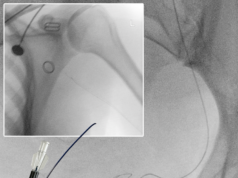
Recently published in the British Journal of Radiology (BJR), a retrospective case-control study has found nulliparity to be “strongly associated” with the incidence of clinically significant post-embolization syndrome (csPES) after uterine artery embolization (UAE).
“This risk factor has not previously been shown to be associated with csPES,” write the authors of the PREDICT-PES study, led by Warren Clements (Alfred Health, Melbourne, Australia). Their cohort, comprised of 69 patients with a mean age of 46.2 years and a mean uterine volume of 393ml, all underwent UAE for symptomatic fibroids between 1 March 2022 and 1 September 2023.
Clements and colleagues defined csPES as the maximum pain score on visual analogue scale of greater than five out of 10, plus at least one of: morphine patient-controlled analgesia dose of less than 10mg, fever, or the use of two or more antiemetics.
The rate of csPES in their cohort was 47.8%, Clements et al report. Most patients had a single fibroid and fibroid disease that was largely intramural in location, while previous pelvic surgery and/or preoperative anaemia was common in both groups. Their results showed that nulliparity increased a patient’s risk of developing csPES by 5.5 times compared to patients who are primiparous or multiparous. Additionally, after adjusting for confounding, the authors report a trend that shows 13% reduced odds of developing csPES for every year increase in age.
The authors note that there have been very few studies identifying which patients are at higher risk of developing a more significant form of PES. In 2009, Ruuskanen et al assessed 62 patients with csPES following UAE and found that a larger volume of embolic agent plus more ischaemia via magnetic resonance imaging (MRI) correlated with the level of pain experienced. Thus, it was suggested that if ischaemia causes pain, larger fibroids and/ or smaller particles are more likely to cause csPES.
Yet, Clements and colleagues detail that this hypothesis has been refuted in a small number of studies to date, showing that postoperative pain did not show an association between median uterine volumes.
“While the univariate analysis in this study did show an association between median uterine volume and csPES, after adjusting for confounders, this was no longer significant and suggests that the effect in our cohort was due to the influence of other variables,” Clements et al write. “This is important as, in the experience of the authors, many women with very large fibroids do not get referred for embolization and are also often not considered suitable for myomectomy. Thus, they may miss out on an opportunity for a uterine-spring treatment.”
Clements et al note several limitations of their study, stating that the Australian demographic and awareness of UAE are reflective of “current referral patterns” resulting in their relatively small cohort size. They state that the short time span of the study was due to the implementation of premedication protocol, which changed from oral to intravenous, meaning the authors were able to evaluate “a controlled group without external influences”.
Practically, the authors state that these results will improve their informed discussion process. As pre-procedure counselling of a patient’s csPES risk is “difficult to predict”, Clements and colleagues note that they previously provided a “more generalised warning to all patients regarding likelihood of pain” following UAE, particularly in nulliparous patients.
“We can use this information to better counsel our patients regarding the odds of csPES when these risks are present, leading to an improved consent process, and the ability to plan more targeted pain management for women who are known to be nulliparous,” the authors conclude.










